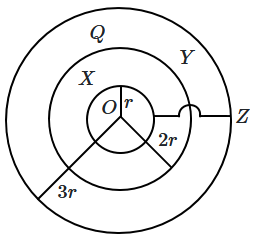An \(L-C-R\) series circuit with a resistance of \(100~\Omega\) is connected to \(200~\mathrm{V}\) (AC source) and angular frequency \(300~\mathrm{rad/s}\). When only the capacitor is removed, then the current lags behind the voltage by \(60^\circ\). When only the inductor is removed the current leads the voltage by \(60^\circ\). The average power dissipated in the original \(L-C-R\) circuit is:
1. \(
50 \mathrm{~W}
\)
2. \( 100 \mathrm{~W}
\)
3. \( 200 \mathrm{~W}
\)
4. \( 400 \mathrm{~W}\)
1. \( 50 \mathrm{~W} \)
2. \( 100 \mathrm{~W} \)
3. \( 200 \mathrm{~W} \)
4. \( 400 \mathrm{~W}\)
The intensity of each of the two slits in Young's double slit experiment is \(I_0\). What is the minimum separation between the points on the screen, where intensities are \(2I_0\) and \(I_0\), if fringe width is \(b\)?
1. \(b \over 5 \)
2. \(b \over 8 \)
3. \(b \over 12 \)
4. \(b \over 4\)
A metal rod at a temperature of \(145^\circ\mathrm{C}\), radiates energy at a rate of \(17~\mathrm{W}\). If its temperature is increased to \(273^\circ\mathrm{C}\), then it will radiate at the rate of:
1. \(
49.6 \mathrm{~W}
\)
2. \( 17.5 \mathrm{~W}
\)
3. \( 50.3 \mathrm{~W}
\)
4. \(67.5 \mathrm{~W}\)
2. 1 : 2
3. 3 : 1
4. 1 : 3
A square wire of side \(2.0~\mathrm{cm}\) is placed \(20~\mathrm{cm}\) in front of a concave mirror of focal length \(10~\mathrm{cm}\) with its centre on the axis of the mirror and its plane normal to the axis. The area enclosed by the image of wire is:
1. \(
7.5 \mathrm{~cm}^2
\)
2. \( 6 \mathrm{~cm}^2
\)
3. \(2 \mathrm{~cm}^2 \)
4. \(
4 \mathrm{~cm}^2\)
A lead bullet penetrates into a solid and melts. Assuming that \(50\%\) of its kinetic energy was used to heat it, the initial speed of the bullet is: (the initial temperature of the bullet is \(25^\circ\mathrm{C}
\) and its melting point is \(300^\circ\mathrm{C}
\)). Latent heat of fusion of lead \(=2.5\times10^4~\mathrm{J/Kg}\) and specific heat capacity of lead \(=125~\mathrm{J/Kg-K}\).
1. \(
100 \mathrm{~m} / \mathrm{s}
\)
2. \( 490 \mathrm{~m} / \mathrm{s}
\)
3. \( 520 \mathrm{~m} / \mathrm{s}
\)
4. \( 360 \mathrm{~m} / \mathrm{s}\)

1. \( 1 / 2 \)
2. \( 1 / 3 \)
3. \( 4 / 3 \)
4. \( 2 / 3\)

| (i) | Ratio of work functions \(\phi_1,\phi_2\) and \(\phi_3\) = 1: 2: 4 |
| (ii) | Ratio of work functions \(\phi_1,\phi_2\) and \(\phi_3\) = 4: 2:1 |
| (iii) | \(\tan\theta\propto\frac{hc}{e},\) Where h = plank’s constant, c = speed of light |
| (iv) | The violet-colour light can eject photoelectrons from metals 2 and 3 |
2. (i), (iv)
3. (ii), (iii)
4. (i), (ii) and (iv)
The concentric, conducting spherical shells \(X,~ Y\) and \(Z\) with radii \(r, ~2r\) and \(3r\) respectively. \(X\) and \(Z\) are connected by a conducting wire and \(Y\) is uniformly charged to charge \(Q\) as shown in the figure. Charges on shells \(X\) and \(Z\) will be:
1. \(qx=\frac{Q}{4},qz=\frac{-Q}{6}\)
2. \(qx=\frac{-Q}{4},qz=\frac{Q}{4}\)
3. \(qx=\frac{Q}{4},qz=\frac{-Q}{4}\)
4. \(qx=\frac{-Q}{6},qz=\frac{Q}{4}\)



